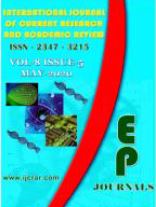Abstract Volume:8 Issue-5 Year-2020 Original Research Articles
 |
Online ISSN : 2347 - 3215 Issues : 12 per year Publisher : Excellent Publishers Email : editorijcret@gmail.com |
2Areka Agricultural Research Centre, p. box 79, Areka, (SARI) Southern Ethiopia
Leek is grown for its thickened cylindrical white and green shaft made up of long leaf bases. The increasing scarcity and competition for irrigation water entails adoption of innovative practices that increase the efficiency of water use. Deficit irrigation provides a means of reducing water consumption while minimizing adverse effects on yield. An experiment was conducted to determine the effects of different level of deficit irrigation treatments compulsory at different active growth periods on the shafts yield of leek (var. Leek variety, namely Kenton) and thereby to identify the critical active growth period of leek for water supply at Gedala-Himbecho in the 2019 and 2020 growing season. The treatment consisted of application of 20, 40, 60 and 80% of the crop water requirement at the early, vegetative, Shafting and maturity periods and application of 20 and 40% of ETc at two consecutive active growth periods of the variety used. The treatments were arranged in RCBD and were replicated three times. Relevant data on soil, amount of irrigation water applied, weather and crop were collected and analyzed. The results showed that application of 20, 40 and 60% of the total water requirement of the crop at shafting period significantly (P<0.05) hastened maturity by 9, 7 and 4 days, respectively as compared to the control treatment. The highest total white shaft yield was obtained from the control treatment followed by application of 40% ETC at shafting plus maturity periods while the lowest total white shaft yield was recorded under the application of 20% ETC at Veg. plus shafting periods. The periods irrigated with 20% ETC and the vegetative growth and shafting periods irrigated with 40% ETC were found to be more susceptible to deficit irrigation than application of 20, 40 and 60% ETC at the other active growth periods. None of the deficit irrigation treatment significantly improved the irrigation water use efficiency of Leek variety, namely Kenton. In order to avoid high yield reduction, this variety should not be stressed at shafting periods and consecutively at any of its growth periods. Under conditions of water shortage, however, the best periods to maximize water saving on irrigation of Leek variety, namely Kenton without a yield reduction of above 31% is application of 40% of its water requirement during the shafting and maturity periods. It is recommended to repeat the experiment for multi-location and different season to confirm the current results.
How to cite this article:
Birhanu Lencha, Belay Yebo and Tesfaye Dejene. 2020. Effect of Different Interval and Water Requiring Growth Time of Leek (Allium ampeloprasum Var. Porrum L) for White Shaft Yield and Yield Components at Wolaita Zone, Ethiopia.Int.J.Curr.Res.Aca.Rev. 8(5): 68-75doi: https://doi.org/10.20546/ijcrar.2020.805.008



Quick Navigation
- Print Article
- Full Text PDF
- How to Cite this Article
- on Google
- on Google Scholor
- Citation Alert By Google Scholar
